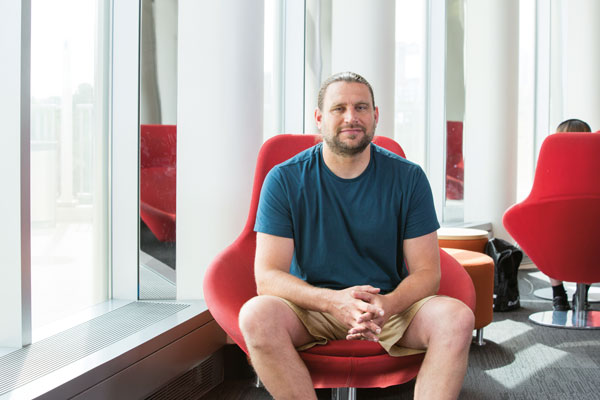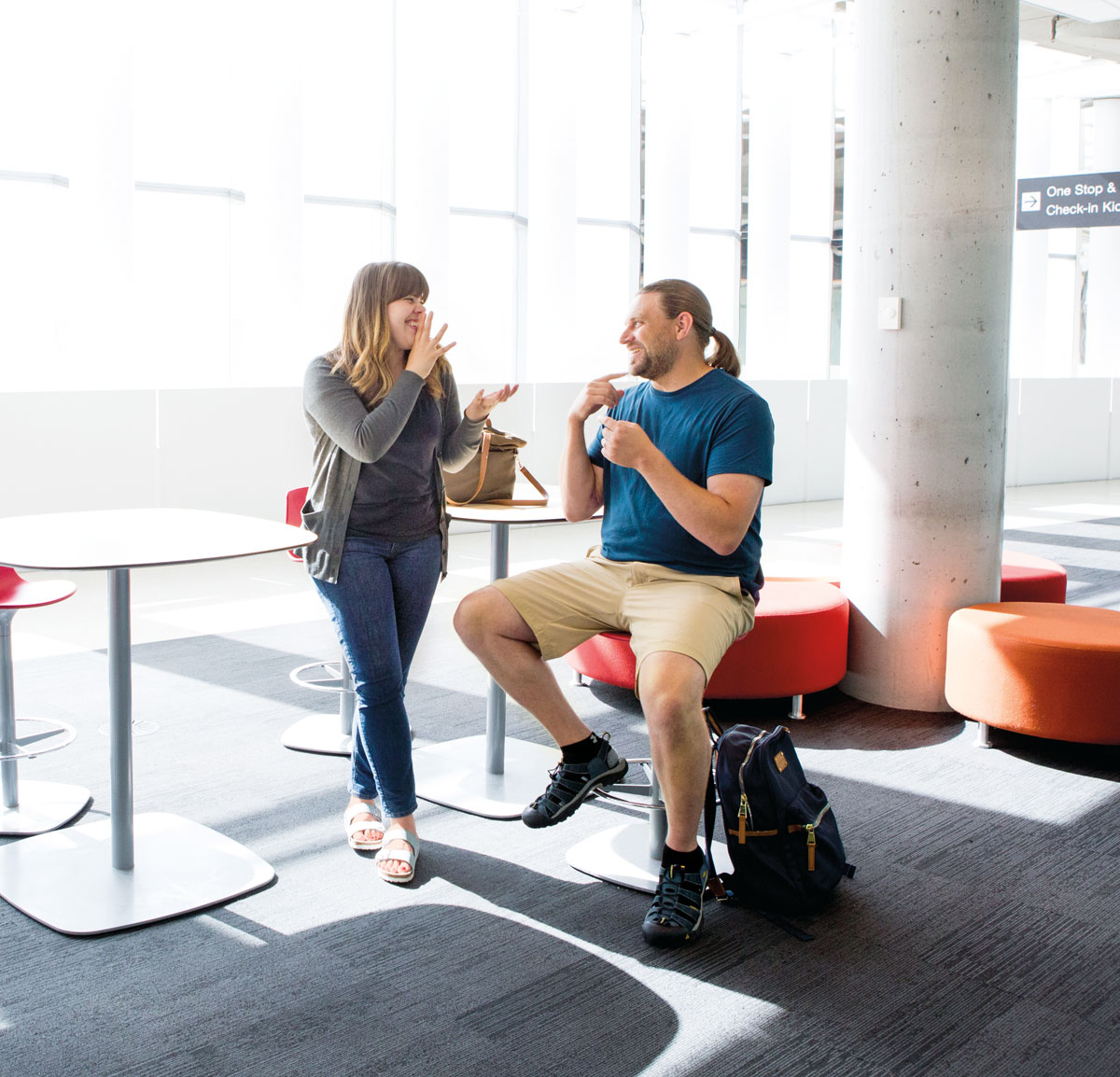From a young age, Robin Johnson learned to communicate with his family in American Sign Language (ASL). He, his parents, and all but one of his siblings are deaf. With interpreters, he attended an elementary school with hearing children in his hometown of Deer River in northern Minnesota. In sixth grade, Johnson’s parents began living in Faribault during the school year so he and his three deaf siblings could attend school at Minnesota State Academy for the Deaf (MSAD).
“Growing up deaf, I came to understand the struggles kids go through,” Johnson says. “There aren’t many deaf teachers out there. I read and write well because I had ‘emergent literacy’ since birth through deaf parents who communicated in ASL. I want to further those skills and help improve literacy in my Deaf community.”
Today, Johnson is a student in the Department of Educational Psychology’s deaf education program, where he’s earning his master of education and deaf and hard-of-hearing (DHH) teaching licensure. Since starting graduate school last fall, Johnson says he’s been impressed with the accommodations—interpreters and note takers—the University’s Disability Resource Center has provided him to support his language needs. He’s enjoyed his DHH classes, which are taught entirely in sign language, with interpreters providing support for communication access between DHH students and hearing students who aren’t fluent in ASL.
“I love having teachers who can sign and who use the same language I do,” says Johnson. “ASL is just as equivalent as English.”

As part of his coursework, Johnson has completed two of his three practicum requirements in two different Twin Cities schools—working with deaf and hard-of-hearing children in an early childhood classroom, and with 18- to 21-year-olds in a transition program.
Johnson has been working in deaf schools in a variety of positions since he graduated in 2000 from Gallaudet University, a leading institution of learning, teaching, and research for deaf and hard-of-hearing students in Washington, DC. Before entering the University’s DHH program, Johnson and his wife were both working and raising their two children. Johnson’s childhood experiences and work with deaf and hard-of-hearing students inspired him to become a teacher. But cost was a barrier.
When Johnson heard about new funding from something called Project PACT, available to students in the DHH program, his dream of being a teacher became a reality.
“Project PACT was the biggest reason I was finally able to apply to the program,” he says.
As for what’s next, Johnson wants to inspire young deaf people to dream big.
“I’d like to be a role model for the younger generations—to see kids grow up and have successful lives,” he says. “That’s the biggest motivation for me.”
Communication for early development
Child development, educational psychology, and deaf-education research tell us language acquisition and social–emotional development start from birth with talking or signing to young children. Because early communication is so critical, there are many negative implications when a child is not exposed to a fully accessible language from birth. For many deaf children, sign language is the only fully accessible language.
Deafness is one of the most common findings during newborn screenings, and over 90 percent of deaf children are born to hearing parents. That means that, unlike Johnson, many deaf children are unable to fluently communicate with their parents in a fully accessible language. For many, school may be the first and only place they are able to fully express themselves.
While most special educators encourage inclusive classrooms—general-education classrooms in which students with and without disabilities learn together—DHH educators may recommend deaf and hard-of-hearing students attend specialized schools for the deaf. This helps them gain access to fluent language models and avoid developmental delays while providing a sense of community and self.
“When DHH kids are delayed in language—for example because they experience language deprivation—this affects both academic and social-emotional development,” says Debbie Golos, associate professor of educational psychology and program coordinator for the DHH program. “Having DHH teachers who are deaf or hard of hearing, and teachers who are fluent in ASL and invite deaf and hard-of-hearing role models into the classroom, provides students with both cultural and linguistic role models to help them form positive identities and develop the necessary skills for academic success.”
Responding to a need for teachers
The University has a long legacy of training teachers of the deaf and hard of hearing. Its DHH program started in the 1950s and was originally housed in the Speech Language Pathology Department in the College of Liberal Arts. In the 1970s, it moved to the College of Education and Human Development through the efforts of Maynard Reynolds, a professor of educational psychology. Reynolds’ interests in teaching deaf children were undoubtedly shaped by watching his father, who was deaf, overcome adversity.
Today, students in the DHH master of education and teaching licensure programs learn the skills they need to teach deaf and hard-of-hearing students from birth through age 21. The two-year program also emphasizes working with families of children who are deaf and hard of hearing to support learning, identity development, respect and equity for ASL and English, and cultural diversity. During the school year, all classes are taught in the evening to allow students—currently employed in schools—to continue working during the day. Students gain a variety of experiences through three practicum placements at different DHH educational settings and with three different DHH age groups throughout their studies. In their final spring semester, students also complete a 15-week, full-time student-teaching practicum. Graduates of the program leave with the qualifications they need to apply for their DHH teaching licensure in Minnesota.
Access through Project PACT
While a few things have changed about the program over the years, some things remain the same. According to the Minnesota Department of Education, DHH teacher positions remain some of the most in-demand in the state. And the program continues to be committed to training more people who are deaf and hard of hearing, like Johnson, to become teachers.
Debbie Golos joined the Department of Educational Psychology and began coordinating the DHH program in 2016. She gets more requests to hire DHH program graduates from schools for the deaf and hard of hearing than she has students to fill those positions, she says.
The program also has a history of receiving and providing funding to prepare future teachers. To help continue to meet the need for DHH teachers, Golos applied for and received $1.2 million in funding from the U.S. Department of Education to support Project PACT, or Preparation About Collaborative Teaching. The project aims to encourage more students to apply to the DHH program—especially highly qualified students who are deaf or hard of hearing, children of deaf adults (CODAs), and parents of children who are deaf or hard of hearing with or without disabilities. Project PACT also funds graduate students in the academic behavioral strategist (ABS) teaching licensure program who are interested in cross collaborations with the DHH program.
With the help of Project PACT, the program is growing. In 2018–19, there were two cohorts in the DHH program totaling 12 students. In 2019, another eight are expected to join the group.
From interpreter to advocate

Christina Skahen, a hearing classmate of Robin Johnson, became involved in the Twin Cities Deaf community as a child. She was close to family friends who were deaf and she attended a church with deaf ministries, where she made friends. Her experiences with the Deaf community sparked her interest in ASL.
“I just really enjoyed being connected to Deaf culture and community and was determined to learn ASL,” Skahen recalls. “This was before the internet, so I would go to the library and rent ASL books or videos. There weren’t that many—maybe four. I would rent them over and over and memorize the signs in each video.”
In high school, Skahen took postsecondary classes in ASL at North Central University. After graduation, she spent a gap year volunteering at a residential school for the deaf in Puerto Rico, working as a paraprofessional in the classrooms, staffing the kitchen, and serving as a resident adviser in the dorms.
“It was my first true immersion experience,” Skahen recalls. “My roommate was deaf, and all of the people on my floor were deaf. I was signing and not talking a lot.”
When Skahen came back to Minnesota, she majored in ASL English interpreting at North Central University in 2013. Since then, she’s been working as an interpreter, often interpreting in metro area schools. Her knowledge of ASL and Deaf culture has made it difficult for her to remain a neutral party.
“I love interpreting, but I’ve also felt really stuck in it,” she says. “As an interpreter, you try to push aside all of your biases.”
According to Skahen, a lot of the DHH teachers she’s met don’t know ASL and often haven’t had much personal life experience with deaf people. This makes it difficult for them to communicate one-on-one with students in their classroom, she explains.
“I would be interpreting and witness a student getting reprimanded for a rule that no one ever explained to him,” Skahen says. “Having to interpret those kinds of conversations was really hard. I got to a breaking point where I just knew I couldn’t keep watching it every day.”
One of Skahen’s friends, who was also an interpreter, suggested she be part of the solution by becoming a DHH teacher. She applied for the Project PACT grant and was thrilled to receive full funding for her master’s and DHH licensure.
Today, Skahen is starting the second year of her program while continuing to work as a freelance interpreter. Thanks to the funding she received from Project PACT, she’s been able to cut back her interpreting to 30 hours a week. “I go to class in the evenings and study all weekend,” she says. “It’s a lot, but it’s worth it to know I can now do more than just watch students struggle. I can make a difference.”
Learn more about the deaf and hard-of-hearing program in the Department of Educational Psychology and Project PACT.
Story by Sarah Jergenson | Photos by Erica Loeks | Fall 2019
 Master's students
Christina Skahen and
Robin Johnson
Master's students
Christina Skahen and
Robin Johnson